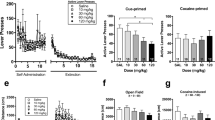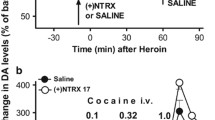Abstract
Rationale
Successful treatment of cocaine addiction is severely impeded by the propensity of users to relapse. Withdrawal severity may serve as a key predictor of susceptibility to relapse. Therefore, the identification and treatment of cocaine withdrawal symptoms such as anxiety may improve addiction treatment outcome.
Objectives
The current study examined the role of anxiety-like behavior during cocaine withdrawal and anxiolytic treatment in reinstatement of cocaine seeking in an animal model of relapse.
Methods
Male rats experienced daily IV cocaine self-administration. One group of animals received the norepinephrine α-2 agonist, guanfacine, or vehicle prior to anxiety testing 48 h after the last self-administration session. In the second group of rats, relationships between cocaine intake, anxiety-like behavior after withdrawal of cocaine, and reinstatement responding were investigated. The third and fourth groups of animals received guanfacine, yohimbine (norepinephrine α-2 antagonist), or vehicle once per day for 3 days 48 h after cessation of cocaine self-administration, followed by extinction and subsequent reinstatement induced by cocaine injections, cocaine-paired cues, and yohimbine administration.
Results
Cocaine-withdrawn rats at 48 h demonstrated higher levels of anxiety-like behavior as measured on a defensive burying task when compared to yoked saline controls, an effect reversed by guanfacine treatment. Cocaine intake was positively correlated with measures of anxiety-like behavior during early withdrawal, and this anxiety-like behavior was significantly correlated with subsequent cocaine-primed reinstatement. Yohimbine treatment during early withdrawal increased reinstatement to conditioned cues, while guanfacine treatment reduced reinstatement to yohimbine.
Conclusions
These studies suggest an important role for noradrenergic mediation of anxiety-like behavior that emerges after withdrawal of cocaine and potential risk of relapse as modeled by reinstatement, and suggest that treatment of anxiety symptoms during early abstinence may reduce the risk of relapse.




Similar content being viewed by others
References
Ahmadi J, Kampman K, Dackis C (2006) Outcome predictors in cocaine dependence treatment trials. Am J Addict 15:434–439
Ahmadi J, Kampman KM, Oslin DM, Pettinati HM, Dackis C, Sparkman T (2009) Predictors of treatment outcome in outpatient cocaine and alcohol dependence treatment. Am J Addict 18:81–86
Ambrose-Lanci LM, Sterling RC, Van Bockstaele EJ (2010) Cocaine withdrawal-induced anxiety in females: impact of circulating estrogen and potential use of delta-opioid receptor agonists for treatment. J Neurosci Res 88:816–824
American Psychiatric Association T (1994) Diagnostic and statistical manual of mental disorders, 4th edn. American Psychiatric Association, Arlington
Antkiewicz-Michaluk L, Filip M, Michaluk J, Romanska I, Patsenka A, Papla I, Przegalinski E, Vetulani J (2006) Conditioned rewarding stimulus associated with cocaine self-administration reverses the depression of catecholamine brain systems following cocaine withdrawal in rats. Int J Neuropsychopharmacol 9:37–50
Aston-Jones G, Harris GC (2004) Brain substrates for increased drug seeking during protracted withdrawal. Neuropharmacology 47(Suppl 1):167–179
Aujla H, Martin-Fardon R, Weiss F (2008) Rats with extended access to cocaine exhibit increased stress reactivity and sensitivity to the anxiolytic-like effects of the mGluR 2/3 agonist LY379268 during abstinence. Neuropsychopharmacology 33:1818–1826
Banna KM, Back SE, Do P, See RE (2010) Yohimbine stress potentiates conditioned cue-induced reinstatement of heroin-seeking in rats. Behav Brain Res 208:144–148
Basso AM, Spina M, Rivier J, Vale W, Koob GF (1999) Corticotropin-releasing factor antagonist attenuates the "anxiogenic-like" effect in the defensive burying paradigm but not in the elevated plus-maze following chronic cocaine in rats. Psychopharmacology 145:21–30
Baumann MH, Milchanowski AB, Rothman RB (2004) Evidence for alterations in alpha2-adrenergic receptor sensitivity in rats exposed to repeated cocaine administration. Neuroscience 125:683–690
Belej T, Manji D, Sioutis S, Barros HM, Nobrega JN (1996) Changes in serotonin and norepinephrine uptake sites after chronic cocaine: pre- vs. post-withdrawal effects. Brain Res 736:287–296
Beveridge TJ, Smith HR, Nader MA, Porrino LJ (2005) Effects of chronic cocaine self-administration on norepinephrine transporters in the nonhuman primate brain. Psychopharmacology 180:781–788
Buffalari DM, See RE (2009) Guanfacine blockade of stress-induced and conditioned cue-induced cocaine-seeking in an animal model of relapse. Soc Neurosci Abstr: 35:387.5
Buffalari DM, See RE (2011) Inactivation of the bed nucleus of the stria terminalis in an animal model of relapse: effects on conditioned cue-induced reinstatement and its enhancement by yohimbine. Psychopharmacology 213:19–27
Carroll KM, Fenton LR, Ball SA, Nich C, Frankforter TL, Shi J, Rounsaville BJ (2004) Efficacy of disulfiram and cognitive behavior therapy in cocaine-dependent outpatients: a randomized placebo-controlled trial. Arch Gen Psychiatry 61:264–272
Cecchi M, Khoshbouei H, Javors M, Morilak DA (2002a) Modulatory effects of norepinephrine in the lateral bed nucleus of the stria terminalis on behavioral and neuroendocrine responses to acute stress. Neuroscience 112:13–21
Cecchi M, Khoshbouei H, Morilak DA (2002b) Modulatory effects of norepinephrine, acting on alpha 1 receptors in the central nucleus of the amygdala, on behavioral and neuroendocrine responses to acute immobilization stress. Neuropharmacology 43:1139–1147
Conrad KL, McCutcheon JE, Cotterly LM, Ford KA, Beales M, Marinelli M (2010) Persistent increases in cocaine-seeking behavior after acute exposure to cold swim stress. Biol Psychiatr 68:303–305
Covington HE 3rd, Miczek KA (2003) Vocalizations during withdrawal from opiates and cocaine: possible expressions of affective distress. Eur J Pharmacol 467:1–13
DeVries AC, Taymans SE, Sundstrom JM, Pert A (1998) Conditioned release of corticosterone by contextual stimuli associated with cocaine is mediated by corticotropin-releasing factor. Brain Res 786:39–46
Economidou D, Dalley JW, Everitt BJ (2011) Selective norepinephrine reuptake inhibition by atomoxetine prevents cue-induced heroin and cocaine seeking. Biol Psychiatr 69:266–274
Erb S (2010) Evaluation of the relationship between anxiety during withdrawal and stress-induced reinstatement of cocaine seeking. Progr Neuro Psychopharmacol Biol Psychiatr 34:798–807
Feltenstein MW, See RE (2006) Potentiation of cue-induced reinstatement of cocaine-seeking in rats by the anxiogenic drug yohimbine. Behav Brain Res 174:1–8
Fuchs RA, Evans KA, Parker MP, See RE (2004) Differential involvement of orbitofrontal cortex subregions in conditioned cue-induced and cocaine-primed reinstatement of cocaine seeking in rats. J Neurosci 24:6600–6610
Fung YK, Richard LA (1994) Behavioural consequences of cocaine withdrawal in rats. J Pharm Pharmacol 46:150–152
Harris GC, Aston-Jones G (1993) Beta-adrenergic antagonists attenuate withdrawal anxiety in cocaine- and morphine-dependent rats. Psychopharmacology 113:131–136
Highfield D, Yap J, Grimm JW, Shalev U, Shaham Y (2001) Repeated lofexidine treatment attenuates stress-induced, but not drug cues-induced reinstatement of a heroin-cocaine mixture (speedball) seeking in rats. Neuropsychopharmacology 25:320–331
Intengan HD, Smyth DD (1997) Alpha-2a/d adrenoceptor subtype stimulation by guanfacine increases osmolar clearance. J Pharmacol Exp Therapeut 281:48–53
Jobes ML, Ghitza UE, Epstein DH, Phillips KA, Heishman SJ, Preston KL (2011) Clonidine blocks stress-induced craving in cocaine users. Psychopharmacology 218(1):83–88
Kampman KM, Volpicelli JR, Mulvaney F, Alterman AI, Cornish J, Gariti P, Cnaan A, Poole S, Muller E, Acosta T, Luce D, O'Brien C (2001) Effectiveness of propranolol for cocaine dependence treatment may depend on cocaine withdrawal symptom severity. Drug Alcohol Depend 63:69–78
Kampman KM, Dackis C, Lynch KG, Pettinati H, Tirado C, Gariti P, Sparkman T, Atzram M, O'Brien CP (2006) A double-blind, placebo-controlled trial of amantadine, propranolol, and their combination for the treatment of cocaine dependence in patients with severe cocaine withdrawal symptoms. Drug Alcohol Depend 85:129–137
Kippin TE, Fuchs RA, See RE (2006) Contributions of prolonged contingent and noncontingent cocaine exposure to enhanced reinstatement of cocaine seeking in rats. Psychopharmacology 187:60–67
Lapiz-Bluhm MD, Bondi CO, Doyen J, Rodriguez GA, Bedard-Arana T, Morilak DA (2008) Behavioural assays to model cognitive and affective dimensions of depression and anxiety in rats. J Neuroendocrinol 20:1115–1137
Le AD, Funk D, Juzytsch W, Coen K, Navarre BM, Cifani C, Shaham Y (2011) Effect of prazosin and guanfacine on stress-induced reinstatement of alcohol and food seeking in rats. Psychopharmacology 218:89–99
Leri F, Flores J, Rodaros D, Stewart J (2002) Blockade of stress-induced but not cocaine-induced reinstatement by infusion of noradrenergic antagonists into the bed nucleus of the stria terminalis or the central nucleus of the amygdala. J Neurosci 22:5713–5718
Mantsch JR, Baker DA, Francis DM, Katz ES, Hoks MA, Serge JP (2008) Stressor- and corticotropin releasing factor-induced reinstatement and active stress-related behavioral responses are augmented following long-access cocaine self-administration by rats. Psychopharmacology 195:591–603
McDougle CJ, Black JE, Malison RT, Zimmermann RC, Kosten TR, Heninger GR, Price LH (1994) Noradrenergic dysregulation during discontinuation of cocaine use in addicts. Arch Gen Psychiatry 51:713–719
Newton TF (2011) A perhaps unexpected role of norepinephrine in actions of MDMA. Clin Pharmacol Ther 90:215–216
O'Leary TA, Rohsenow DJ, Martin R, Colby SM, Eaton CA, Monti PM (2000) The relationship between anxiety levels and outcome of cocaine abuse treatment. Am J Drug Alcohol Abuse 26:179–194
Pellow S, Chopin P, File SE, Briley M (1985) Validation of open:closed arm entries in an elevated plus-maze as a measure of anxiety in the rat. J Neurosci Meth 14:149–167
Pinel JPJ, Treit PJ (1978) Burying as a defensive response in rats. J Comp Physiol Psychol 92:708–712
Platt DM, Rowlett JK, Spealman RD (2007) Noradrenergic mechanisms in cocaine-induced reinstatement of drug seeking in squirrel monkeys. J Pharmacol Exp Therapeut 322:894–902
Poling J, Kosten TR, Sofuoglu M (2007) Treatment outcome predictors for cocaine dependence. Am J Drug Alcohol Abuse 33:191–206
Preti A (2007) New developments in the pharmacotherapy of cocaine abuse. Addict Biol 12:133–151
Rudoy CA, Van Bockstaele EJ (2007) Betaxolol, a selective beta(1)-adrenergic receptor antagonist, diminishes anxiety-like behavior during early withdrawal from chronic cocaine administration in rats. Progr Neuro Psychopharmacol Biol Psychiatr 31:1119–1129
Sarnyai Z, Biro E, Gardi J, Vecsernyes M, Julesz J, Telegdy G (1995) Brain corticotropin-releasing factor mediates 'anxiety-like' behavior induced by cocaine withdrawal in rats. Brain Res 675:89–97
Schroeder JP, Cooper DA, Schank JR, Lyle MA, Gaval-Cruz M, Ogbonmwan YE, Pozdeyev N, Freeman KG, Iuvone PM, Edwards GL, Holmes PV, Weinshenker D (2010) Disulfiram attenuates drug-primed reinstatement of cocaine seeking via inhibition of dopamine beta-hydroxylase. Neuropsychopharmacology 35:2440–2449
Schuckit MA, Daeppen JB, Danko GP, Tripp ML, Smith TL, Li TK, Hesselbrock VM, Bucholz KK (1999) Clinical implications for four drugs of the DSM-IV distinction between substance dependence with and without a physiological component. Am J Psychiatr 156:41–49
Shepard JD, Bossert JM, Liu SY, Shaham Y (2004) The anxiogenic drug yohimbine reinstates methamphetamine seeking in a rat model of drug relapse. Biol Psychiatry 55:1082–1089
Sinha R (2001) How does stress increase risk of drug abuse and relapse? Psychopharmacology 158:343–359
Smith RJ, Aston-Jones G (2008) Noradrenergic transmission in the extended amygdala: role in increased drug-seeking and relapse during protracted drug abstinence. Brain Struct Funct 213:43–61
Smith RJ, Aston-Jones G (2011) alpha(2) Adrenergic and imidazoline receptor agonists prevent cue-induced cocaine seeking. Biol Psychiatry 70(8):712–719
Sofuoglu M, Kosten TR (2006) Emerging pharmacological strategies in the fight against cocaine addiction. Expert Opin Emerg Drugs 11:91–98
Sofuoglu M, Sewell RA (2009) Norepinephrine and stimulant addiction. Addict Biol 14:119–129
Sofuoglu M, Gonzalez G, Poling J, Kosten TR (2003) Prediction of treatment outcome by baseline urine cocaine results and self-reported cocaine use for cocaine and opioid dependence. Am J Drug Alcohol Abuse 29:713–727
Sofuoglu M, Dudish-Poulsen S, Poling J, Mooney M, Hatsukami DK (2005) The effect of individual cocaine withdrawal symptoms on outcomes in cocaine users. Addict Behav 30:1125–1134
Sofuoglu M, Poling J, Waters A, Sewell A, Hill K, Kosten T (2008) Disulfiram enhances subjective effects of dextroamphetamine in humans. Pharmacol Biochem Behav 90:394–398
Stoops WW, Blackburn JW, Hudson DA, Hays LR, Rush CR (2008) Safety, tolerability and subject-rated effects of acute intranasal cocaine administration during atomoxetine maintenance. Drug Alcohol Depend 92:282–285
Uhlen S, Wikberg JE (1991) Delineation of rat kidney alpha 2A- and alpha 2B-adrenoceptors with [3 H]RX821002 radioligand binding: computer modelling reveals that guanfacine is an alpha 2A-selective compound. Eur J Pharmacol 202:235–243
Yang XM, Gorman AL, Dunn AJ, Goeders NE (1992) Anxiogenic effects of acute and chronic cocaine administration: neurochemical and behavioral studies. Pharmacol Biochem Behav 41:643–650
Zhang XY, Kosten TA (2005) Prazosin, an alpha-1 adrenergic antagonist, reduces cocaine-induced reinstatement of drug-seeking. Biol Psychiatr 57:1202–1204
Acknowledgments
This research was supported by National Institute on Drug Abuse grants DA16511 and DA21690 (RES), 1F32 DA025411-01 (DMB), and NIH grant C06 RR015455. The authors thank Shannon Ghee and Bernard Smalls for technical assistance and data collection.
Author information
Authors and Affiliations
Corresponding author
Rights and permissions
About this article
Cite this article
Buffalari, D.M., Baldwin, C.K. & See, R.E. Treatment of cocaine withdrawal anxiety with guanfacine: relationships to cocaine intake and reinstatement of cocaine seeking in rats. Psychopharmacology 223, 179–190 (2012). https://doi.org/10.1007/s00213-012-2705-1
Received:
Accepted:
Published:
Issue Date:
DOI: https://doi.org/10.1007/s00213-012-2705-1




